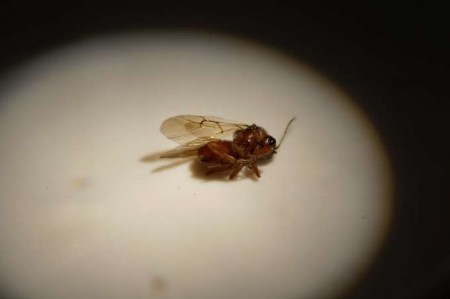The Hart Museum remains closed. Los Angeles County has approved a plan to transfer the William S. Hart Museum and Park from the County to the City of Santa Clarita.
Oak Wasp Galls
Let me introduce you to a tiny parasitic wasp that makes a unique nursery for its offspring.

Originally published: Oct. 31, 2013
Meet the Oak Gall Wasp:

To construct her nursery, female Oak Gall Wasps employ a not-so-subtle subterfuge. Instead of working to find and construct a nest of her own, the wasp turns to the mighty oak and bends it to her will! Eggs are gently inserted into the flesh of the oak's limbs and cause the area to swell. These deformaties are better known as galls, and help to protect and feed the developing wasp larvae that hatch inside. Although they are sometimes referred to as plant tumors, these growths are not harmful to the oak. Galls made by this particular wasp, can grow to the size of a small babies fist, and to the untrained eye look like apples. Therefore, they are often referred to as oak apples. What if one were to pick said oak apple and take it into their office? What would happen? This is exactly what Carol Bornstein, Director of the Museum's Nature Gardens, did two weeks ago. Though Carol knew exactly what she was plucking from the Valley Oak, Quercus lobata, in our Nature Gardens, she ended up getting a bit more than she bargained for. A few days later—in the middle of a meeting no less—an unsuspecting Museum staffer, saw a tiny wasp skittering over her desk. Being a diligent worker, he quickly scooped the tiny insect into a handy vial (who doesn't go to meetings with vials in their pockets?) and brought it to my office.
Needless to say, I was excited! I've been waiting for a gall to grow on our oaks since they were planted two years ago. With a little sleuthing, I was able to find out the exact identity of our little waspy. Valley Oaks are often afflicted with galls of two varieties, those that look like apples, caused by the Cynipid gall wasp, Adricus californicus, and others that looks like Hershey Kisses, formed by A. kingi. Here's the gall in question:

It doesn't take Sherlock Holmes to figure out which species we have...Andricus californicus! So, now it's your turn. Go out and find some unsuspecting oaks and start looking for galls. If you get truly inspired, you might want to purchase the Field Guide to Plant Galls of California and Other Western States, because then you'll be able to start going on adventures looking for everyone of the 300 species covered. It's a gall new world!